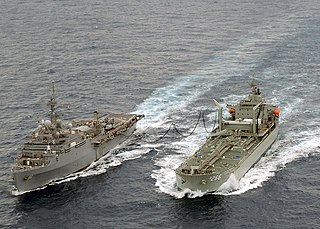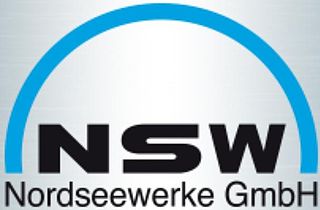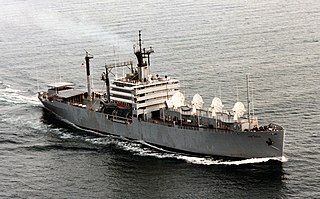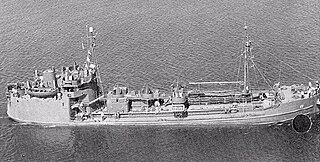
The Finnish Navy is one of the branches of the Finnish Defence Forces. The navy employs 2,300 people and about 4,300 conscripts are trained each year. Finnish Navy vessels are given the ship prefix "FNS", short for "Finnish Navy ship", but this is not used in Finnish language contexts. The Finnish Navy also includes coastal forces and coastal artillery.

A merchant ship, merchant vessel, trading vessel, or merchantman is a watercraft that transports cargo or carries passengers for hire. This is in contrast to pleasure craft, which are used for personal recreation, and naval ships, which are used for military purposes.

A replenishment oiler or replenishment tanker is a naval auxiliary ship with fuel tanks and dry cargo holds which can supply both fuel and dry stores during underway replenishment (UNREP) at sea. Many countries have used replenishment oilers.

The T2 tanker, or T2, was a class of oil tanker constructed and produced in large quantities in the United States during World War II. Only the T3 tankers were larger "navy oilers" of the period. Some 533 T2s were built between 1940 and the end of 1945. They were used to transport fuel oil, diesel fuel, gasoline and sometimes black oil-crude oil. Post war many T2s remained in use; like other hastily built World War II ships pressed into peacetime service, there were safety concerns. As was found during the war, the United States Coast Guard Marine Board of Investigation in 1952 stated that in cold weather the ships were prone to metal fatigue cracking, so were "belted" with steel straps. This occurred after two T2s, Pendleton and Fort Mercer, split in two off Cape Cod within hours of each other. Pendleton's sinking is memorialized in The Finest Hours. Engineering inquiries into the problem suggested the cause was poor welding techniques. It was found the steel was not well suited for the new wartime welding construction. The high sulfur content made the steel brittle and prone to metal fatigue at lower temperatures.

A tanker is a ship designed to transport or store liquids or gases in bulk. Major types of tankship include the oil tanker, the chemical tanker, and gas carrier. Tankers also carry commodities such as vegetable oils, molasses and wine. In the United States Navy and Military Sealift Command, a tanker used to refuel other ships is called an oiler but many other navies use the terms tanker and replenishment tanker.

Nordseewerke Emden GmbH was a shipbuilding company, located in the Emden Harbor of the north German city of Emden. Founded in 1903, shipbuilding ended in 2010, and the company was taken over by the Schaaf Industrie AG, which among other products, makes components for off-shore systems.

The Type 704 Rhön-class tankers are a series of replenishment oilers used by the German Navy to provide underway replenishment for its ships at sea. The two vessels in the class, Rhön and Spessart, were originally constructed for Libya by Kröger Shipyard in Rendsburg, West Germany as bulk acid carriers. They were acquired by the West German Navy in 1976 for conversion and entered service in 1977. The two ships are crewed by civilians. In 2019 it was announced by the German Navy that the ships are planned to be replaced in 2024.

Kawasaki Heavy Industries Ship & Offshore Structure Company is the shipbuilding subsidiary of Kawasaki Heavy Industries. It produces primarily specialized commercial vessels, including LNG carriers, LPG carriers, container ships, bulk carriers, oil tankers, as well as high speed passenger jetfoils. In addition, it is also a producer of warships for the Japan Maritime Self-Defense Force, including submarines. Kawasaki also produces marine machinery, including marine engines, thrusters, steering gears, deck and fishing machinery.

A tracking ship, also called a missile range instrumentation ship or range ship, is a ship equipped with antennas and electronics to support the launching and tracking of missiles and rockets. Since many missile ranges launch over ocean areas for safety reasons, range ships are used to extend the range of shore-based tracking facilities.

An oil tanker, also known as a petroleum tanker, is a ship designed for the bulk transport of oil or its products. There are two basic types of oil tankers: crude tankers and product tankers. Crude tankers move large quantities of unrefined crude oil from its point of extraction to refineries. Product tankers, generally much smaller, are designed to move refined products from refineries to points near consuming markets.

The T3 tanker, or T3, are a class of seaworthy large tanker ships produced in the United States and used to transport fuel oil, gasoline or diesel before and during World War II, the Korean War and the Vietnam War. The T3 tanker classification is still used today. The T3 tanker has a full load displacement of about 24,830 tons.
The Eddy-class coastal tankers were Royal Fleet Auxiliary Replenishment oilers built from 1951–1953 tasked with transporting and providing fuel and other liquids to Royal Navy vessels and stations around the world. There were originally ten ships planned in the class, although the final two were cancelled in 1952. Originally designed to act as fleet attendant oilers, in this role the ships were obsolete almost as soon as they were built due to the increasing prevalence of replenishment at sea, and their role was refocused to coastal transport duties.
RFA Darkdale was a Dale-class fleet tanker of the Royal Fleet Auxiliary (RFA), launched on 23 July 1940 as Empire Oil, completed in November 1940 and transferred to the RFA as Darkdale. She was sunk during the Second World War on 22 October 1941 by the German submarine U-68. Her wreck in James Bay off Jamestown, Saint Helena continued to leak oil, posing a potential environmental threat to the coastal waters of Saint Helena, until Ministry of Defence divers drained the ship's tanks in 2015.

The T1 tanker or T1 are a class of sea worthy small tanker ships used to transport fuel oil before and during World War II, Korean War and Vietnam War. The T1 tanker classification is still in use today. T1 tankers are about 200 to 250 feet in length and are able to sustain a top speed of about 12 knots. The hull designation AO is used by the US Navy to denote the ship is a T1 oil tanker and AOG that the T1 is a gasoline tanker. The small size allows the T1 to enter just about any sea port or to anchor around a small island, this was very useful during the Pacific War. The T1 tanker can carry about 48,000 to 280,000 bbls. Some T1 tankers were used to transport goods other than oil, a few were used for black oil-crude oil, diesel, chemicals and rarely bulk cargo like grain. T1 tankers are also called liquid cargo carriers. The T1 tanker has about a 6,000 to 35,000 deadweight tonnage (DWT) of cargo. The small size also gives the ships short turn around time for repair, cleaning, loading and unloading. A T1 tanker carrying dirty cargo, like crude oil needs a few weeks of labor to clean before carrying clean cargo. Most T1 ships during World War II were named after major oil fields. T1 tankers are operated by the US Navy, War Shipping Administration and United States Maritime Commission. Some T1s were loaned to England in the Lend-Lease program for World War II, after the war most were returned to the US. After World War II many of the T1 ships were sold to for civilian use. Each T1 had emergency life rafts on the boat deck. The ships had cargo booms and piping to load and unload fuel. During war time the T1 are armed for protection with deck guns. A typical ship may have one single 3"/50 dual purpose gun, two 40 mm guns and three single Oerlikon 20 mm cannon. A T1 at war time normally had a crew of 38 and up to 130. If operating as a United States Merchant Marine ship, the crew would be a mix of civilian Merchant Marines and United States Navy Armed Guards to man the guns.
The following index is provided as an overview of and topical guide to Wikipedia's articles on recreational dive sites. The level of coverage may vary:











